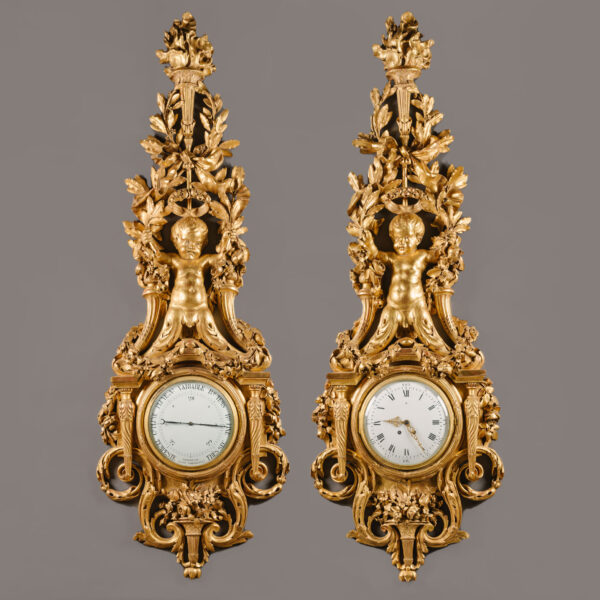Sèvres (Estilo)
Reloj de pared de bronce dorado y barómetro a juego con placas de Sèvres
£34,000
A Very Fine Gilt-Bronze Wall Clock and Matching Barometer with Sèvres Plaques. The dial of the clock signed ‘JULIEN LEROY A PARIS’, the barometer...
Dimensiones
Height: 68 cm (27 in)Width: 30 cm (12 in)
Depth: 8 cm (4 in)
Descripción
A Very Fine Gilt-Bronze Wall Clock and Matching Barometer with Sèvres Plaques.
The dial of the clock signed ‘JULIEN LEROY A PARIS’, the barometer dial signed ‘PASSEMANT AU LOUVRE’.
The eight day strike Wall Clock and its matching Barometer, both have a terminal in the form of a pineapple drop with acanthus leaf scroll detail. Above this is a Sèvres panel of a cherub in a garden, rising to a white enamelled dial with Arabic and Roman numerals flanked by cascading relief moulded fruit from a further Sèvres panel of a cherub in flight below a ribbon tied pediment.
This companion clock and barometer are fine nineteenth century examples of a pair originally supplied to Madame du Barry in 1769 by the marchand-mercier Simon-Philippe Poirier. They were then described as ‘Un Baromètre & Thermomètre, de Passement, montés trés richement en bronze dorés d’or moulu et ornés de trois plaques de porcelainede france à Enfants en miniature cy 10561I.’ It is interesting to note that the original design was made to allow either of three porcelain plaques, depicting putti with astrolabes. Eighteenth century models are now in the permanent collection of the Victoria & Albert Museum in London, the Musée du Louvre in Paris, the Metropolitan Museum of Art in New York.
Fecha
Alrededor de 1880
Origen
Francés
Medio
Gilt-Bronze and Porcelain
Firma
The dial of the clock signed ‘JULIEN LEROY A PARIS’, the barometer dial signed ‘PASSEMANT AU LOUVRE’.
The Sèvres Porcelain Manufactory was founded to the east of Paris in the disused Royal Château of Vincennes, late in 1739-40. and moved to the village of Sèvres, west of Paris in 1756, en route to King Louis XV’s palace of Versailles.
Here it was also adjacent to Louis’s mistress Madame de Pompadour’s own château at Bellevue. She was delighted with the factory’s new location – as she knew she could entice Louis to take a greater interest in it when it was so near their own residences. Indeed, the King became such a keen patron of the factory that, when it ran into financial difficulties, he bought out the shareholders and became the sole proprietor. The factory remained a royal enterprise until the French Revolution, when it was nationalised.
The popularity of the Louis XV style during the nineteenth century led to a number of companies in and around Paris, creating exceptional Sèvres-Style porcelain based on eighteenth century models and to the same exceptional quality. Often these pieces were of exhibition quality and scale, and finely painted by the best studio painters of the day such as Robert, Desprez and Poitevin.
TAMBIÉN TE PUEDE GUSTAR
-
£45,000 Añadir a la cesta

Etienne Maxant
Un Gran Cartel de Applique con marquetería de bronce dorado y Boulle de estilo Regencia, a la manera de André-Charles Boulle
-
£3,200 Añadir a la cesta

A Patinated and Gilt-Bronze Hanging Clock, with an enamelled dial and Arabic Numerals
-
£35,000 Añadir a la cesta

Juego de reloj y barómetro de madera dorada tallada estilo Luis XVI









 Imprimir
Imprimir